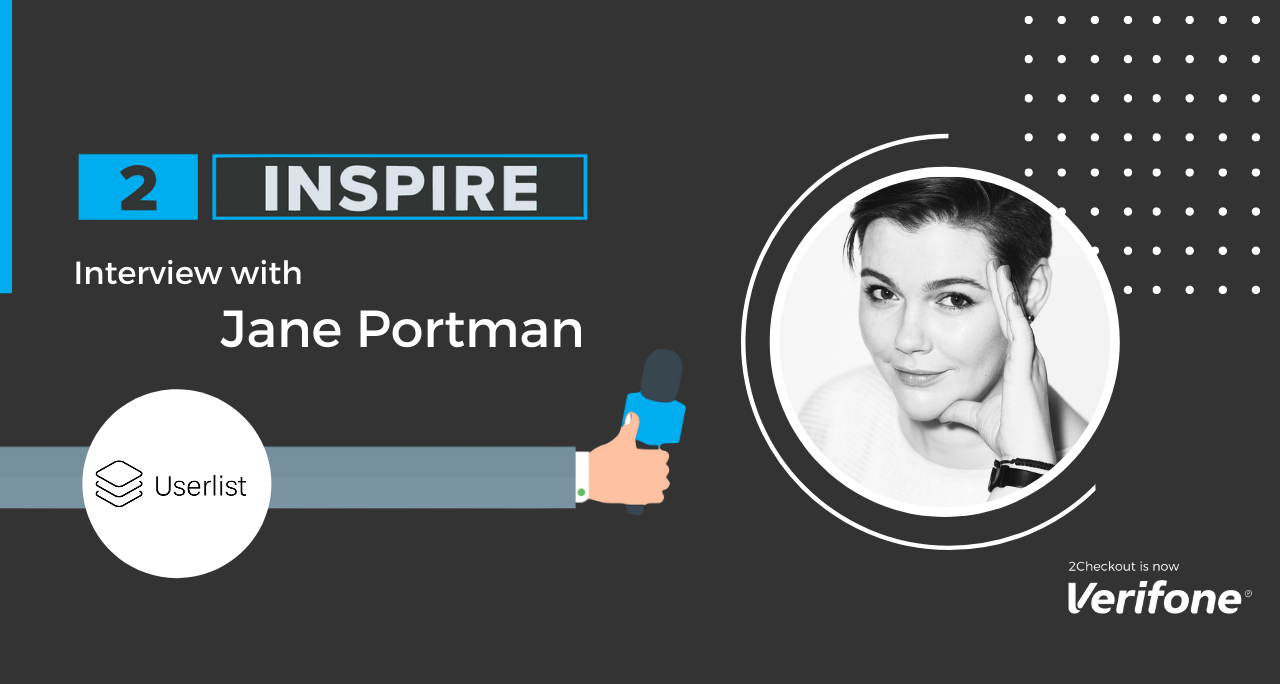The newest episode of the 2Inspire Interview Series, where eCommerce thought leaders and practitioners share their experiences and lessons, is out!
We couldn’t be more excited to have Jane Portman as our special guest for this episode. Jane was previously a UI/UX consultant specializing in web application design. She later co-founded Userlist, a tool that helps SaaS founders achieve awesome results on their customer messaging. Her experience as a consultant and founder gave her a rich perspective on the industry. As you’ll discover from the interview, Jane is also very passionate about podcasts as a form of building thought leadership, so it’s no surprise that she hosts two of them: UI Breakfast and Better Done Than Perfect (we highly encourage you to check them out 👀).
We’re going to warm up with some valuable lessons Jane learned as a founder, and then we’re jumping straight into the nitty-gritty of building and growing your SaaS product and business – Jane will share her learnings and insights all the way from product inception through to tried-and-tested strategies for improving SaaS adoption rates, onboarding, and growth. Watch the full interview below and make sure you have your notebook close by, as there are a lot of key takeaways you will want to note!
Check out the full interview below:
Interview Excerpts:
Q1: Could you share more about your entrepreneurial journey? (00:15)
“I’ve been an aspiring SaaS founder for many years. Previously a UI/UX consultant, I’ve always worked with other founders and have wanted to have my own product. So, in 2017, we got together as a team of three and decided to develop a solution for SaaS founders that we thought addressed a problem that wasn’t being addressed well, and that was the problem of customer messaging, a little bit of customer management, and just an overall tool that would be a great fit for SaaS founders when they need to send behavior-based messaging.”
Q2: What are some lessons you’ve learned as a SaaS founder? (01:05)
“I think being a founder gives you unique insight into how a business operates that you can never get being a consultant. The primary lesson is that it’s always a tale of resources. There is no lack of ideas or methods, but you really have limited resources – limited time, limited team member bandwidth – and it’s all a matter of juggling priorities in a way that makes the right things happen.”
Q3: What is your philosophy on building successful products? (01:41)
“One of the approaches that I would recommend to anybody who is starting out there is to not sit down and fish for ideas inside their head. Instead, use research and really try to understand what your target audience is in need for. To do that you can go to different forums or places they hang out and truly understand what they’re talking about.”
Q4: How can businesses design an effective product positioning strategy? (02:11)
“We have tweaked our positioning a few times. We have been changing the way we describe what our product can do – we started out as email automation, then we swapped for customer messaging. To do that we used April Dunford’s 10-step method that helps you analyze customer pains you’re solving, cluster them into certain themes, and then figure out who you’ll be serving. That was really helpful. Then we changed the positioning this year to email automation once again, because we added marketing email to our list of features.
Always try for an existing market category, that would be my advice. If you come up with an idea, and somehow it doesn’t exist as a product category yet, it’s a big warning sign and you’re going to have to spend tons of resources to try and educate your customer. It’s the last thing you want to do as a small startup founder.”
Q5: What are some customer research methods you have successfully used to understand your users? (03:22)
“The biggest research method we’ve been using is different types of customer interviews. We did a round of customer interviews in the early days before even starting to build anything, to validate our suspicion about the target market. Then, last year, we did a grandiose round of interviews with people who could be our customers, but for some reason were not. And we did use the methodology described in The Mom Test book by Rob Fitzpatrick, which is trying to address the problem and understand how the customer feels about it and what they do right now exactly, before even starting to talk about your product. So, it’s not about the way customers use your product, but the way customers run their business and how your product could potentially fit in there. That’s the angle we take and jobs-to-be-done is another angle we try to use there as well.”
Q6: What does great product messaging look like? (04:39)
“Great means that you’re not just clearly describing what your product does, but also hitting all the necessary pain points, so the purchasing decision is made as easy as possible for your customers.”
Q7: How can businesses improve product adoption rates? (05:00)
“There is always so much any business can do to improve their adoption. There is a huge library of resources you can be building from day one and then improving over the years. You can be offering help docs, you can be offering different types of onboarding calls, you can be offering different kinds of activities. The whole spectrum of done-for-you services, ranging from guidance to the complete concierge, white-glove setup, there is really a whole range of things. Of course, we do recommend for you to use email automation as the backbone of your user onboarding so that you don’t have to manually check in on customer progress. The software can do that for you based on user behavior data. That just really streamlines the flow and helps you to focus on outstanding or problematic accounts. All other check-ins can be done automatically.”
Q8: What are the user onboarding principles that SaaS businesses need to consider? (06:04)
“The key principle there is to not try to instruct the user, but instead, empower them to do what they need to do. A lot of founders take onboarding as a step-by-step instructional guide – they use tooltips, tours, and other things. But that doesn’t work like that, the user always has a much stronger internal motivation when they arrive to use your product. So, you should provide all the resources available. However, you should strive to do that in a way that does not block the natural flow of exploration. And as you progress with your software product, you can experiment with this, you can be super prescriptive, and try and figure out the core two or three steps that need to be done and really force them. Experimentation and basically any effort in that direction is much better than none.”
Q9: What will be some UI trends for online businesses in 2022? (07:35)
“The key UI trend is more and more customers are becoming really design-savvy and the quality bar for any software is really rising, so the quality bar for UI/UX is also equally high. However, founders and designers also have as many tools as possible at their disposal, much more than they used to have in the early days. And also, the designer aesthetic we are observing these days, it’s really clean, minimal. Designers are empowered as they have never been. So just balance this consumer expertise and your own capabilities to achieve the best UI/UX possible. However, from my experience as a consultant in the past, the best products are those that succeed in spite of bad UI/UX, meaning that great design can definitely help you improve adoption, but it will not rescue your bad product-market fit.”
Q10: What way of accelerating SaaS growth has worked best for you? (08:48)
“We still haven’t really figured a single way of getting customers, but for us, the best way has been to build our expertise as a company in the market. And to achieve that, we’ve been producing content both in the form of articles and podcast shows. Podcasting is something that’s really dear to the heart of my co-founder and me. So, we run three shows – I run my own show called UI Breakfast, my co-founder, Benedikt, runs Slow and Steady where they talk with other SaaS founders about their progress, and we also have the third show that was created specifically for Userlist, Better Done Than Perfect. So, this has been just a mix of our passion and achieving results with that. Other than that word-of-mouth is probably the biggest channel for us right now, and just gradually building that authority and referrals over time.”
Q11: What is an online tool you rely on the most and can further recommend? (10:02)
“There were two tools that we adopted in our marketing stack this year. One is Livestorm which we use for our multiple workshops hosted on our platform, or even as guest partnerships. And another tool I really love is Pitch, a design tool for presentations. I was really amazed that finally somebody was able to solve the presentation problem. I was wondering, is there a tool out there that is doing it in a really beautiful and modern way, and I was amazed to learn that such a tool does exist. Pitch and their library of templates is just downright amazing.”
Q12: Who are some inspirational people you look up to and why? (10:56)
“There is a range of people that I have learned from in the early days of my entrepreneurial journey and that I’d love to spread the word about. Some of these are Joanna Wiebe of Copyhackers with their amazing copywriting resources, Patrick McKenzie with his amazing consulting advice that’s slowly turned into SaaS advice. Nathan Barry, in his old days, was promoting his book Authority which taught other people to write helpful books and to use them as a marketing tool. His book was really great guidance when I wrote my first book, and then I have done another three of them, and that turned into a great path to build my design career. Then there is Stacking the Bricks by Alex Hillman and Amy Hoy. They do promote the Sales Safari, which is the way of doing customer search – you’re supposed to go and find places where your customers hang out, so you never have to build products that are not a great fit.”
Q13: What is the best book you’ve read lately? (12:16)
“I really appreciate books that teach some new concepts that I can apply in my business thinking daily afterwards. Antifragile by Nassim Taleb is great and it taught me a few things. Crucial Conversations by Kerry Patterson and a number of other authors is another great book. It teaches you just general business skills. Another book by Andrew S. Grove, High Output Management, is more like a classic management book that is super concise, and just teaches you the management basics. As founders, we’ve been slowly shifting from just working on the product to building our team, and that’s been our theme for this year.”
Q14: What is the best advice you’ve ever received? (13:06)
“In 2013, I was showing my new consulting website to one of my clients, and he said, “Jane, your copy is terrible.” I was like, why is it bad? I don’t make really bad mistakes in English. Why do you say so? And he then pointed me towards Joanna Wiebe’s website and that’s how I ventured into this world of business copywriting. And as of today, in spite of being a designer, I still do think that copy is much more important for any business, any website, and any material.”
Q15: What is a piece of advice you’d give to fellow women who want to start a SaaS business? (13:59)
“Start small, iterate, and just keep going because the whole SaaS journey is about being persistent and just keep making small mistakes until you learn.”
Stay in the Know!
We hope you have enjoyed this episode packed with real-life tactics and strategies for your SaaS business. If this has triggered your appetite for more, you can always check out the previous installments of the series:
- 2Inspire Series – Interview with Kristina Quinones, Director of Growth Marketing at Automattic
- 2Inspire Series – Interview with Tamara Grominsky, Chief Strategy Officer at Unbounce
- 2Inspire Series – Interview with Tim Soulo, CMO of Ahrefs
Stay tuned for our upcoming 2Inspire episodes!





